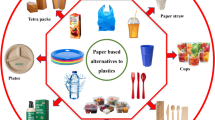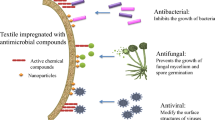Abstract
Polystyrene surfaces were conditioned with surfactin and rhamnolipid biosurfactants and then assessed regarding the attachment of Staphylococcus aureus, Listeria monocytogenes, and Micrococcus luteus. The effect of different temperatures (35, 25, and 4°C) on the anti-adhesive activity was also studied. Microbial adhesion to solvents and contact angle measurements were performed to characterize bacteria and material surfaces. The results showed that surfactin was able to inhibit bacterial adhesion in all the conditions analyzed, giving a 63–66% adhesion reduction in the bacterial strains at 4°C. Rhamnolipid promoted a slight decrease in the attachment of S. aureus. The anti-adhesive activity of surfactin increased with the decrease in temperature, showing that this is an important parameter to be considered in surface conditioning tests. Surfactin showed good potential as an anti-adhesive compound that can be explored to protect surfaces from microbial contamination.


Similar content being viewed by others
References
Bellon-Fontaine MN, Rault J, van Oss CJ (1996) Microbial adhesion to solvents: a novel method to determine the electron-donor/electron-acceptor or Lewis acid–base properties of microbial cells. Colloids Surf B 7:47–53
Chae MS, Schraft H, Hansen LT et al (2006) Effects of physicochemical surface characteristics of Listeria monocytogenes strains on attachment to glass. Food Microbiol 23:250–259
Di Bonaventura G, Piccolomini R, Paludi D et al (2008) Influence of temperature on biofilm formation by Listeria monocytogenes on various food-contact surfaces: relationship with motility and cell surface hydrophobicity. J Appl Microbiol 104:1552–1561
Donlan RM, Costeron JW (2002) Biofilms: survival mechanisms of clinically relevant microorganisms. Clin Microbiol Rev 15:167–193
Dunne MW (2002) See any good biofilm lately? Clin Microbiol Rev 15:155–166
Gautam KK, Tyagi VK (2006) Microbial surfactants: a review. J Oleo Sci 55:155–166
Goulter RM, Gentle IR, Dykes GA (2009) Issues in determining factors influencing bacterial attachment: a review using the attachment of Escherichia coli to abiotic surfaces as an example. Lett Appl Microbiol 49:1–7
Meylheuc T, van Oss CJ, Bellon-Fontaine MN (2001) Adsorption of biosurfactant on solid surfaces and consequences regarding the bioadhesion of Listeria monocytogenes LO28. J Appl Microbiol 91:822–832
Myers D (2006) Surfactant science and technology, 3rd edn. Wiley, Hoboken, pp 337–349
Nitschke M, Costa SGVAO (2007) Biosurfactants in food industry. Trends Food Sci Technol 18:252–259
Nitschke M, Pastore GM (2004) Biosurfactant production by Bacillus subtilis using cassava processing effluent. Appl Biochem Biotechnol 112:163–172
Nitschke M, Costa SGVAO, Haddad R et al (2005) Oil wastes as unconventional substrates for rhamnolipid biosurfactant production by Pseudomonas aeruginosa LBI. Biotechnol Prog 21:1562–1566
Nitschke M, Araújo LV, Costa SGVAO et al (2009) Surfactin reduces the adhesion of food-borne pathogenic bacteria to solid surfaces. Lett Appl Microbiol 49:241–247
Palmer RJ, White DC (1997) Developmental biology of biofilms: implications for treatment and control. Trends Microbiol 5:435–440
Palmer J, Flint S, Brooks J (2007) Bacterial cell attachment, the beginning of a biofilm. J Ind Microbiol Biotechnol 34:577–588
Pelletier C, Bouley C, Cayuela C et al (1997) Cell surface characteristics of Lactobacillus casei subsp. casei, Lactobacillus paracasei subsp. paracasei, and Lactobacillus rhamnosus strains. Appl Environ Microbiol 63:1725–1731
Rodrigues LR, Banat MI, van der Mei HC et al (2006) Interference in adhesion of bacteria and yeasts isolated from explanted voice prostheses to silicone rubber by rhamnolipid biosurfactants. J Appl Microbiol 100:470–480
Singh P, Cameotra SS (2004) Potential applications of microbial surfactants in biomedical sciences. Trends Biotechnol 22:142–146
Walencka E, Rózalska S, Sadowska B et al (2008) The influence of Lactobacillus acidophilus-derived surfactants on staphylococcal adhesion and biofilm formation. Folia Microbiol 53:61–66
Acknowledgments
The authors would like to thank the financial support provided by Conselho Nacional de Desenvolvimento Científico e Tecnológico (CNPq) and Coordenação de Aperfeiçoamento de Pessoal de Nível Superior (CAPES).
Author information
Authors and Affiliations
Corresponding author
Rights and permissions
About this article
Cite this article
Zeraik, A.E., Nitschke, M. Biosurfactants as Agents to Reduce Adhesion of Pathogenic Bacteria to Polystyrene Surfaces: Effect of Temperature and Hydrophobicity. Curr Microbiol 61, 554–559 (2010). https://doi.org/10.1007/s00284-010-9652-z
Received:
Accepted:
Published:
Issue Date:
DOI: https://doi.org/10.1007/s00284-010-9652-z




